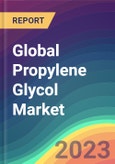Propylene Glycol is a colourless and odourless liquid chemical with the IUPAC name Propane -1,2 diol. Commercially, Propylene Glycol is manufactured by the hydration of Propylene Oxide. Di and tri-propylene glycol as well as small quantities of higher glycols are also produced in the reaction. Propylene glycol is a synthetic material which readily absorbs water. Propylene glycol is used to synthesize polyester composites and is employed as a base for de-icing solutions. Propylene glycol finds applications in the chemical, pharmaceutical, and food industries as an antifreeze when leakage might lead to contact with the food product. The Food and Drug Administration (FDA) has classified it as an additive generally recognized as safe” for applications in the food industry. It is used to absorb excess water and preserve moisture in some food, medication, and cosmetic goods. Moreover, artificial fog or smoke made from propylene glycol is employed in theatre shows and firefighter training.
The majority of the total Propylene Glycol produced globally, is used as a food additive in the food & beverage sector. It is utilized to retain moisture and absorb excess water in specific pharmaceutical, cosmetic, or food items. It is a solvent used in the paint and plastics industries, as well as for food colours and flavors. In Cosmetic Industry, it is used for skincare products, hair care products, soaps as well as color cosmetics due to its super freezing point, humectant, and mould inhibiting properties. Rising disposable income coupled with changing lifestyles and increasing adoption of beauty trends is anticipated to fuel the market growth in the forecast period. In the coming years, the automotive sector is expected to be the fastest-growing sector owing to the increasing application of Propylene Glycol as engine coolant, deicing fluid in aircraft, hydraulic fluids, etc. The total demand for Propylene Glycol is anticipated to reach approximately 3800 thousand tonnes in 2035.
Regionally, the North America region is dominating the Propylene Glycol market, followed by Europe and Asia Pacific region. North America consumed approximately 36% of the total Propylene Glycol demand across the globe. Due to the enormous demand for this organic compound in the food & beverage industry and as well as applications in pharmaceuticals and cosmetics, the demand for Propylene Glycol is expected to rise significantly over the course of the projection period. Factors such as blooming construction, packaging, and food & beverage sectors along with other industries, coupled with growing population and urbanization in the Asia Pacific region are expected to boost the Propylene Glycol market through 2035.
Based on grade, the Propylene Glycol market is segregated into USP, Industrial, and Technical Grade. Among these, the USP grade is the most widely used in the globe. This grade captured more than 40% of the market in the year 2022.
Based on the end-user industry, the global Propylene Glycol market is segmented into Food & Beverage, Pharmaceuticals, Cosmetics, Automotive, and Others. Among these, the Food & Beverage industry is the key consumer of the Propylene Glycol market. In 2022, this industry held about 28% of the market share and is anticipated to dominate the market even in the forecast period. Surging demand for ready-to-eat food items demands higher amounts of Propylene Glycol, likely to augment market expansion.
Major players in the production of Global Propylene Glycol are LyondellBasell, Dow Chemical, SK Chemicals, ADM, Indorama Ventures, Monument Chemical, INEOS, BASF, Shell Eastern Petroleum, CNOOC & Shell Petrochemicals (CSPC), Dongying Hi Tech Spring Chemical Ltd, Manali Petrochemicals, and Others.
Years considered for this report:
- Historical Period: 2015- 2022
- Base Year: 2022
- Estimated Year: 2023
- Forecast Period: 2024-2035
Objective of the Study:
- To assess the demand-supply scenario of Propylene Glycol which covers production, demand and supply of Propylene Glycol market in the globe.
- To analyse and forecast the market size of Propylene Glycol
- To classify and forecast Global Propylene Glycol market based on end-use and regional distribution.
- To examine competitive developments such as expansions, mergers & acquisitions, etc., of Propylene Glycol market in the globe.
The publisher calculated Propylene Glycol demand in the globe by analyzing the historical data and demand forecast which was carried out considering the raw materials to produce Propylene Glycol . The publisher sourced these values from industry experts and company representatives and externally validated through analyzing historical sales data of respective manufacturers to arrive at the overall market size. Various secondary sources such as company websites, association reports, annual reports, etc., were also studied by the publisher.
Key Target Audience:
- Propylene Glycol manufacturers and other stakeholders
- Organizations, forums and alliances related to Propylene Glycol s distribution
- Government bodies such as regulating authorities and policy makers
- Market research organizations and consulting companies
Report Scope:
In this report, Global Propylene Glycol s market has been segmented into following categories, in addition to the industry trends which have also been detailed below:- Market, by Grade: USP, Industrial, and Technical Grade
- Market, by End-Use: Food & Beverage, Pharmaceuticals, Cosmetics, Automotive, and Others
- Market, by Sales Channel: Direct Sale and Indirect Sale
- Market, by Region: North America, Europe, Asia Pacific, Middle East and Africa, and South America.








